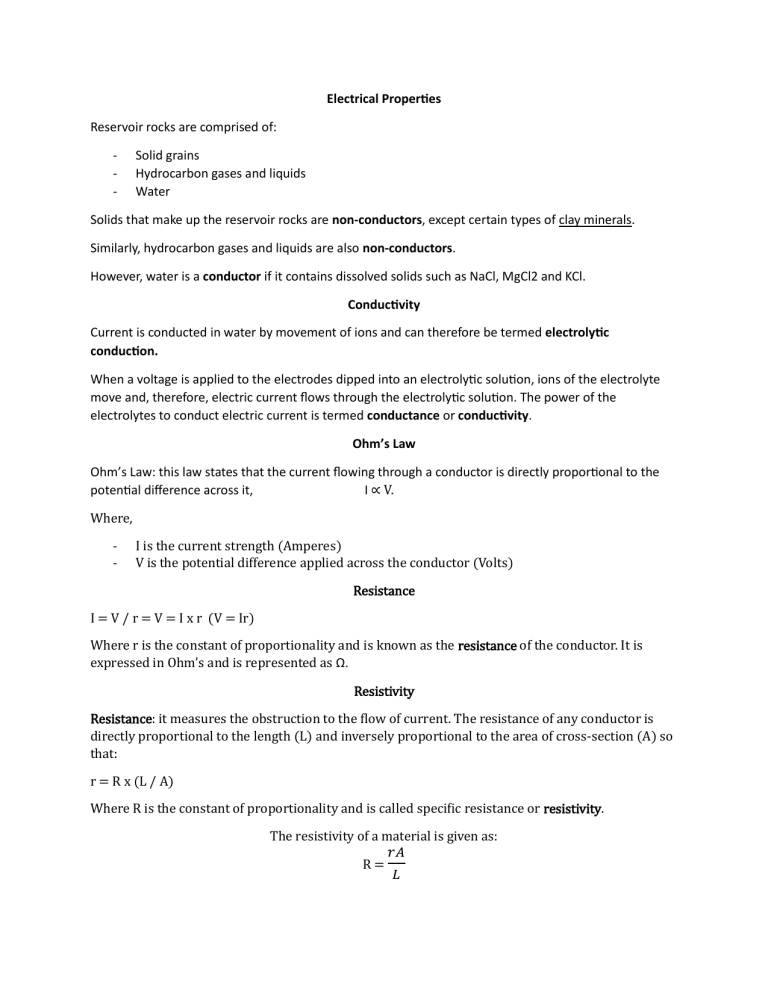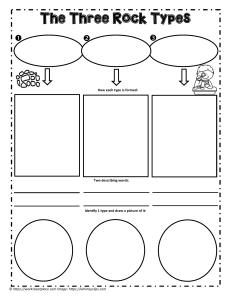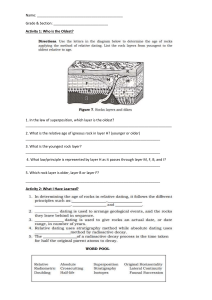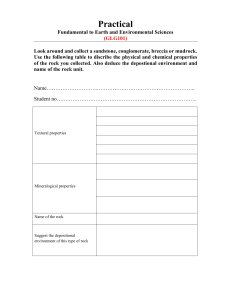
Electrical Properties Reservoir rocks are comprised of: - Solid grains Hydrocarbon gases and liquids Water Solids that make up the reservoir rocks are non-conductors, except certain types of clay minerals. Similarly, hydrocarbon gases and liquids are also non-conductors. However, water is a conductor if it contains dissolved solids such as NaCl, MgCl2 and KCl. Conductivity Current is conducted in water by movement of ions and can therefore be termed electrolytic conduction. When a voltage is applied to the electrodes dipped into an electrolytic solution, ions of the electrolyte move and, therefore, electric current flows through the electrolytic solution. The power of the electrolytes to conduct electric current is termed conductance or conductivity. Ohm’s Law Ohm’s Law: this law states that the current flowing through a conductor is directly proportional to the potential difference across it, I ∝ V. Where, - I is the current strength (Amperes) V is the potential difference applied across the conductor (Volts) Resistance I = V / r = V = I x r (V = Ir) Where r is the constant of proportionality and is known as the resistance of the conductor. It is expressed in Ohm’s and is represented as Ω. Resistivity Resistance: it measures the obstruction to the flow of current. The resistance of any conductor is directly proportional to the length (L) and inversely proportional to the area of cross-section (A) so that: r = R x (L / A) Where R is the constant of proportionality and is called specific resistance or resistivity. The resistivity of a material is given as: 𝑟𝐴 R= 𝐿 Where, R is the resistivity (Ohm-cm), r is the resistance (Ohm), A is the cross-sectional area of the conductor (cm2) L is the length of the conductor (cm) Let us consider a cube of salty water having cross-sectional area A, length L and resistivity Rw. If an electrical current is caused to flow across the cube through an area A and a length L, the resistance of the cube can be determined. Let the resistance be 𝑟1 . Then, 𝑟1 = 𝑅𝑤𝐿 𝐴 Now consider a cube of porous rock of the same dimensions of the above cube and 100% saturated with salty water (brine) of resistivity Rw. Remembering that the solids are non-conductors, the electric flow must be through the water-filled pores. The cross-sectional area available for conduction is now Aa – the actual or effective cross section of the water filled pores. The path length of current flow is increased to a value La, the average length that an ion must traverse in passing through the pore channels. 1. Formation factor F= 𝑅0 𝑅𝑤 = 𝐿𝑎 ∕𝐿 𝐴𝑎 ∕𝐴 = √𝜏 𝐴𝑎 ∕𝐴 𝜏 is the tortuosity. 2. Resistivity Index I = 𝑅𝑡 𝑅0 = 𝐴𝑎 ∕𝐴′𝑎 𝐿𝑎 ∕𝐿′𝑎 Electrical vs. Physical properties: The above relationships of F and I to geometric dimensions are not very useful. But those two quantities can be related to physical parameters such as porosity and saturation. If pore openings are considered continuous: Aa = Φ xA Substituting into Formation Factor equation: La/L 1/porosity Substituting into Resistivity Index = L’a/L 1/Sw F = aporosity^-m Mechanical properties of reservoir rocks Rock mechanics is the area that includes the Strength of properties of rocks. Mechanical properties of rocks are evaluated based on stress – strain relationships. Stress refers to the force applied to a rock that tends to change its dimensions. It is commonly denoted by o. The external force applied to a rock is called as LOAD O = F/A o = stress (Pascal) F = applied force, (N) A = area where the force is applied (m^2) Types of Stress There are three basic recognized stress conditions: 1. Tensile stress: It is the type of stress in which the two sections of material on either side of a stress plane tend to pull apart or elongate. 2. Compressive stress This stress is exactly the opposite of tensile stress; adjacent parts of the material tend to press against each other, or external forces are directed toward each other along the same plane. By convention, a compressive force is taken to be negative, which yields a negative stress. 3. Shear stress Shear stress occurs when the external forces are parallel and directed to opposite directions but in different planes. Strain is the relative change in shape or size of a rock due to externally applied forces, i.e. stress. It is commonly denoted by E. E = L – Lo / Lo E = strain L = length of a rock after applying the stress, cm Lo = original length of a rock before any load is applied, cm. Tensile strains are positive but because Lo is greater than L, compressive strains are negative. In most materials, as stress increases, for a certain time, strain also increases and is proportional to the stress. If the strain goes back to zero, when stress is removed, it is called elastic deformation or elastic strain. If the stress continues to increase, the material yields, i.e., it reaches a point where even if the stress is removed, the strain does not go back to zero. This deformation or strain is called plastic deformation or plastic strain. The point of initial departure from linearity of the stress-strain curve is called the proportional limit. The proportional limit value is difficult to measure precisely. Therefore, a convention has been established by which a straight line is constructed parallel to the elastic portion of the stress-strain curve at some specified strain offset, usually 0.002. The stress corresponding to the intersection of this line and the stress-strain curve is defined as the yield strength, oy. The exact nature of the stress-strain relationship depends on the characteristics of the rock. Ductility: is a solid material’s ability to deform under tensile stress; this is often characterized by the material’s ability to be stretched into a wire. Brittleness: a material is brittle if, when subjected to stress, it breaks without significant deformation (strain). Brittle materials absorb relatively little energy prior to fracture, even those of high strength. Breaking is often accompanied by a snapping sound. Brittle materials include most ceramics and glasses (which do not deform plastically). Several factors including mineralogy and fluids contained in the rock affect the stress – strain relationship. It is important to understand these factors: - At the initial reservoir conditions And to measure how these factors are related with the mechanical behavior of the rock. Rock strength The strength of a solid material is its ability to resist stress without yielding or to resist deformation. Tensile strength: resistance against pulling apart. Compressive strength: resistance to compression. Shear strength: resistance to shear stress. Compressive strength is the significant strength of the reservoir rocks. For example, it is critical to understand the well-bore stability during drilling and production. Poisson’s ratio: it is an elastic constant that is a measure of the compressibility of material perpendicular to applied stress. Or the ratio of latitudinal to longitudinal strain. It is commonly denoted by V. V = -Elatitudinal / Elongitudinal = -(change in d/original d)/(change in L/original L) do = original diameter of a cylindrical core sample Lo = original length of a cylindrical core sample Change in d = change in the diameter Change in L = change in length Young’s modulus: it is defined as the ratio of longitudinal stress to longitudinal strain. It is denoted by E. E = (F/A)/(change in L/original L) Modulus of rigidity: it is also known as shear modulus. It is a measure of the resistance of a body to change in shape. It is denoted by G. G = shear stress/shear strain. Bulk modulus: it gives the change in volume of a solid substance as the pressure on it is changed. It is denoted by K K = change in pressure/(change in volume/original volume) = 1/Cr (Cr = matrix compressibility) Laboratory measurement of rock strength Compressive strength: Uniaxial test: A cylindrical core is loaded axially until it fails. Triaxial test: A cylindrical core is placed in a cell, subjected to all-around (confining) pressure by a confining fluid (typically hydraulic oil or water) acting through an impermeable membrane, and loaded axially to failure. Triaxial test can be done in following conditions: Axial pressure in equal increments / axial pressure at a constant rate. Dry / saturated Drained / undrained. Tensile strength: Direct pull test: A cylindrical core sample is anchored at both ends and stretched. Brazilian test: A relatively thin disk of the rock is loaded across the diameter until it splits. Beam flexure test: A thin slab of rock is loaded vertically when supported along its length. Reservoir rock compressibility: Production of fluids from the reservoir rocks -> change in internal stress in the formation -> an increased and variable load on the rocks -> compaction of the rock structure due to an increased effective stress -> changes in the grain, pore and bulk volume of the rock. Rock matrix (grain) compressibility: The fractional change in the volume of the solid rock material with a unit change in pressure under isothermal conditions. Cr = −1/Vr(Vr/P)T Rock bulk compressibility: The fractional change in bulk volume of the rock material with a unit change in pressure under isothermal conditions. Pore compressibility: The fractional change in the pore volume of the rock material with a unit change in pressure under isothermal conditions. Cr and Cb << Cp Cf = formation compressibility and commonly equated to Cp Ct = total reservoir compressibility Co = oil compressibility Cg = gas compressibility Cw = water compressibility Ct = SgCg + SoCo + SwCw + Cf Multiple Fluid Saturations There exists at least two kinds of fluid present in petroleum reservoirs. - Hydrocarbon Water Many times, three different types of fluids - Hydrocarbon gas Hydrocarbon liquid Water The simultaneous existence of two or more kinds of fluids in porous media requires some terms to be defined: - Capillary pressure Wettability Relative permeability If there exists only one fluid in the reservoir One set of forces to be considered. - The attraction between the rock and the fluid If there exists more than one fluid in the reservoir, at least three sets of forces to be considered: - Example: Oil and water present in the reservoir o Oil – water interaction o Oil – rock interaction o Water – rock interaction Surface tension and interfacial tension In dealing with multiphase systems, it is necessary to consider the effect of the forces acting at the interface when two immiscible fluids are in contact. When these two fluids are liquid and gas, the term surface tension is used to describe the forces acting on the interface. When the interface is between two liquids, a solid and a gas, or a solid and a liquid the acting forces are called interfacial tension. Consider the two immiscible fluids, air and oil as shown schematically below. A liquid molecule, which is remote from the surface, is surrounded by other liquid molecules, thus having a resultant net attractive force on the molecule of zero. A liquid molecule at the interface, however, has a force acting on it from the air molecules lying immediately above the interface and from the liquid molecules lying below the interface. The resulting force is unbalanced and gives rise to surface tension. Free surface energy A certain amount of work is required to move a water molecule from within the body of the fluid through the interface. This work is frequently referred to as “the free surface energy of the fluids”. Free surface energy, in ergs per square centimeter, may be defined as the work necessary to create a unit area of new surface. (erg is a unit of energy) The interfacial tension and surface tension are commonly expressed in dynes/cm, which is numerically equal to the surface energy in ergs/cm^2. (dyne is a unit of force) The interfacial tension, σ, is the force per unit length required to create a new surface. In dealing with immiscible multiphase systems, it is necessary to consider not only the interface between the two immiscible fluids but also the forces that are active between the fluids and the solids. The combination of all the active forces determines the wettability and capillary pressure of a porous rock. Wettability: is defined as the relative ability of a fluid to spread on a solid surface in the presence of another immiscible fluid (air or liquid). The oil/water interface will assume a shape corresponding to the minimum energy, such that the contact angle, theta, defines the wettability. By convention, the contact angle is measured through the denser fluid and ranges from 0 to 180 degrees. The solid surface is said to be preferentially wet by denser phase when contact angle is between 0 and 75 degrees. The solid surface is said to be preferentially wet by less dense phase when contact angle is between 105 and 180 degrees. By considering all the effective forces at static equilibrium the adhesion tension is defined as: At = σ_so – σ_sw = σ_wo*cos(contact angle) At = Adhesion tension σ_so = interfacial tension between solid and oil A positive adhesion tension indicates that the denser phase preferentially wets the solid surface. Wetting phase makes a film over the surface of the rock. The wetting phase occupies the smaller pores. Wettability affects the following phenomena: - Relative distribution of fluids in porous medium. Capillary pressure Relative permeability characteristics Hydrocarbon production Capillarity: If a short length glass capillary tube is placed in a large open vessel partly filled with water, with the medium grade oil on top of water. The capillary tube is immersed in the liquids, so that it crosses the oil/water interface; the water level will rise inside the tube. The following relationship is derived by considering the balance of force up and force down. Force up = interfacial tension forces = 2*pi*r*At Force down = Hydrostatic force = pi*r^2*h*g*(water density – oil density) r = radius of tube. h = height of water column g = acceleration of gravity At = adhesion tension. Equating these two forces: 2*pi*r*At = pi*r^2*h*g*(water density – oil density) h = 2*pi*r*At/pi*r^2*g(denw-deno) = 2σ_wocos(contact angle)/rg(denw-deno) The capillary forces in petroleum reservoirs are the result of the combined effect of the - Surface and interfacial tensions of rock and fluids Pore size and geometry Wetting characteristics of the system. Capillary pressure: When two immiscible fluids are in contact, a discontinuity in pressure exists between the fluids, which depends upon the curvature of the interface separating the fluids. The displacement of wetting phase with non-wetting phase is known as drainage. The displacement of a non-wetting phase with a wetting phase is known as imbibition. Migration of hydrocarbons is a drainage process.






